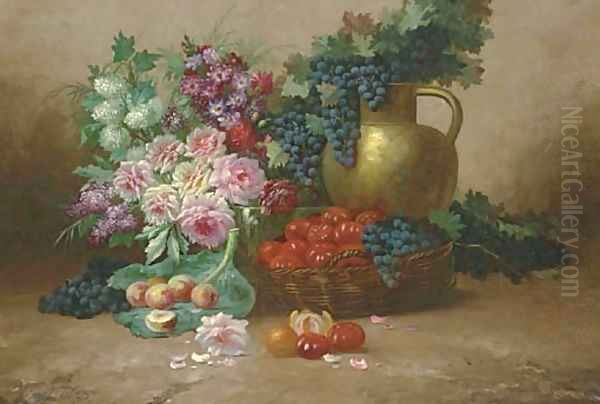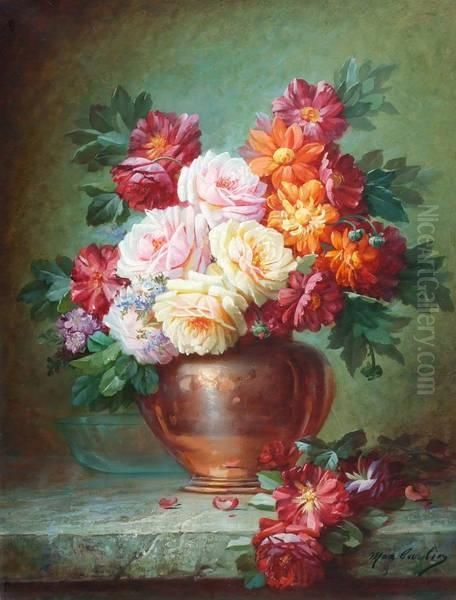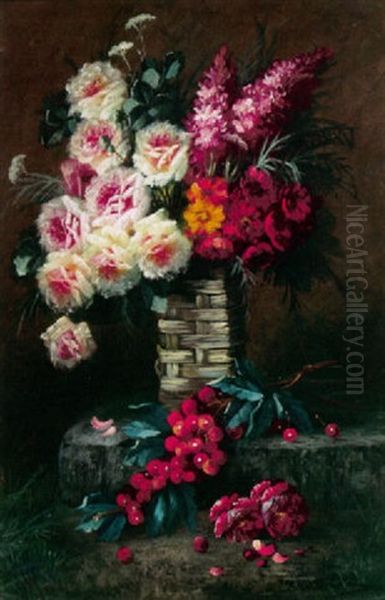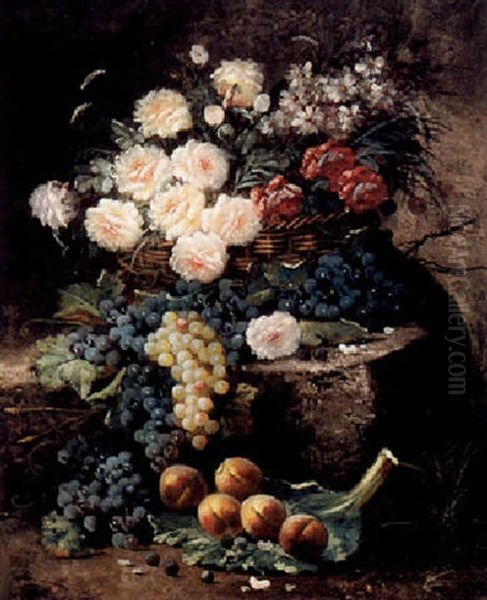Max Carlier, born in 1872 and passing away in 1938, stands as a notable figure in Belgian art history, particularly celebrated during the late 19th and early 20th centuries. His artistic legacy is primarily built upon his exquisite still life paintings, with a pronounced focus on floral compositions. Carlier's work is admired for its capacity to capture the ephemeral beauty of nature while often imbuing his subjects with a sense of quiet dignity and historical resonance. He operated within a rich artistic milieu, contributing significantly to the Belgian visual arts landscape of his time.
His paintings are often characterized by a remarkable attention to detail, showcasing a delicate handling of texture and a vibrant, expressive use of color. Carlier possessed a keen ability to render the interplay of light and shadow, bringing depth and life to his canvases. Through his dedicated practice, he carved a distinct niche for himself, becoming synonymous with the genre of floral still life in Belgium during his era.
Biographical Notes and Artistic Formation
While Max Carlier achieved considerable recognition for his art, specific details regarding his formal education and personal life remain somewhat elusive in readily available records. Standard art historical accounts focus predominantly on his output and stylistic development rather than extensive biographical anecdotes. It is important to distinguish him from other individuals named Carlier who were prominent in different fields during similar periods, such as the French aviator Marcel Carlier or the researcher Jacques Carlier, to avoid historical confusion.
Max Carlier's artistic journey unfolded during a dynamic period in European art, bridging the traditions of the 19th century with the emerging currents of modernism. Although concrete information about his teachers or academy training is scarce, his work itself speaks volumes about his grounding in traditional painting techniques, particularly those associated with the rich heritage of Flemish art. His dedication to his craft suggests a rigorous, likely self-motivated, study of both nature and the masters who preceded him.
The Essence of Carlier's Art: Still Life and Florals

The core of Max Carlier's oeuvre lies in the realm of still life, specifically the depiction of flowers. He demonstrated a profound affinity for capturing the intricate beauty of blooms, often arranging them in vases or baskets within carefully composed interior settings. His choice of subject matter frequently included popular flowers like roses and violets, rendered with a sensitivity that highlighted their delicate forms and lush colors.
His works often depict these floral arrangements placed near windows or on draped tables, creating intimate domestic scenes. These settings are not mere backdrops but integral components of the composition, contributing to the overall mood. Carlier masterfully used elements like tablecloths, curtains, and the subtle suggestion of room interiors to enhance the sense of warmth, tranquility, and stability that permeates his paintings. The resulting atmosphere is typically one of peacefulness, elegance, and quiet contentment.
Carlier's technical prowess is evident in his meticulous rendering of textures – the softness of petals, the coolness of porcelain vases, the richness of fabrics. His application of paint reveals a careful layering and blending technique, achieving both realism and a painterly quality. The interplay of light, often depicted as soft, natural light filtering in from a nearby window, is handled with exceptional skill, illuminating the central floral subject while casting gentle shadows that add depth and dimension to the scene.
Artistic Style: Tradition and Interpretation
Max Carlier's style is deeply rooted in the realist tradition, particularly the esteemed lineage of Flemish still life painting that flourished in the 17th century. Artists like Jan Brueghel the Elder and Ambrosius Bosschaert established a benchmark for detailed floral depiction, symbolic richness, and technical perfection. Carlier clearly studied and absorbed this tradition, echoing its emphasis on meticulous observation, fine brushwork, and the celebration of natural beauty within a domestic context.
His works often share the characteristic moderate sizing found in traditional Flemish still lifes, making them well-suited for intimate viewing and home decoration. This connection to the historical masters provided a solid foundation for his art. However, Carlier was not merely an imitator; he brought his own sensibility to the genre, interpreting it through the lens of his own time.

While primarily a realist, subtle influences or parallels with broader artistic currents of his era can be discerned, albeit interpreted through his distinct style. Some analyses suggest connections to the general atmosphere of Modernism in his exploration of nature and perhaps even a subtle resonance with the color sensibilities explored by contemporaries influenced by Impressionism or Post-Impressionism, such as the focus on light and vibrant palettes seen in the works of artists like Henri Fantin-Latour or even the early works of Henri Matisse and Pablo Picasso, though Carlier never ventured into their more radical stylistic innovations. His work retains a commitment to representational accuracy that sets it apart from the avant-garde movements like Surrealism or Constructivism, even if his compositions sometimes evoke a reflective, almost dreamlike quietude. His unique contribution lies in this blend: upholding the technical rigor of the Flemish tradition while infusing his paintings with a gentle, warm, and distinctly personal atmosphere relevant to his time.
Representative Works and Their Characteristics
Among Max Carlier's most recognized works are paintings frequently titled Still Life with Flowers (often specified as oil on canvas) and Bouquet. These pieces serve as excellent examples of his artistic strengths and thematic preoccupations. A typical Still Life with Flowers by Carlier might present a lavish arrangement of various blooms spilling from a vase, set upon a polished table or windowsill. The background is often rendered with care, suggesting a comfortable interior space, perhaps with a glimpse of the outside world through a windowpane.
His painting Bouquet exemplifies his skill in composition and color harmony. Such works often feature a generous collection of flowers, showcasing his ability to differentiate textures and hues, from the velvety petals of roses to the delicate structure of smaller blossoms. The scale of works like Bouquet can be substantial, allowing for a high degree of detail and creating an immersive visual experience for the viewer.
These representative works consistently display the hallmarks of Carlier's style: meticulous detail, rich and harmonious color palettes, skillful manipulation of light and shadow to create depth and realism, and the evocation of a peaceful, often luxurious, domestic setting. They embody his love for floriculture and his ability to translate that passion into visually captivating art that conveys feelings of happiness, serenity, and abundance.
Contemporaries and Artistic Context
Max Carlier worked during a vibrant period in European art history. While he focused on a more traditional genre, he was a contemporary of artists exploring a wide range of styles. In Belgium itself, artists were engaging with Impressionism, Symbolism, and early Modernism. Although Carlier maintained his distinct realist focus, he operated within this broader context.

His contemporaries, or artists active during his lifetime whose work provides context, include figures from various movements and nations. The French painter Henri Eugene Cauchois (1850-1911) also specialized in floral still lifes, offering a point of comparison in terms of subject matter, though often with a slightly looser, more Impressionistic touch. The Danish-American painter Soren Emil Carlsen (1853-1932) was renowned for his sensitive still lifes, sharing with Carlier a dedication to careful observation and subtle tonal harmonies, though Carlsen's subjects often included copper pots and game alongside flowers.
Other notable artists active during Carlier's lifespan include the influential landscape painter Camille Corot (1796-1875), whose later career overlapped with Carlier's early years and whose emphasis on light and atmosphere impacted generations. The sculptor and painter Albert-Ernest Carrier-Belleuse (1824-1887) was a prominent figure in French academic art, known for his decorative style. The sculptor Jean-Baptiste Carpeaux (1827-1875) represented a dynamic, expressive realism in sculpture.
Further contemporaries include the landscape painter Antoine Chintreuil (1814-1873), the animalier sculptor and painter Auguste-Nicolas Cain (1821-1894), the Symbolist painter Eugène Carrière (1849-1906), known for his misty, monochromatic style, and the Fauvist painter Charles Camoin (1879-1965), representing the more avant-garde trends Carlier coexisted with. Later in Carlier's life, artists like Jean-Pierre Cassigneul (b. 1935) would continue traditions of figurative painting, while figures like Marc Chagall (1887-1985) pushed the boundaries of modern art. This diverse list underscores the rich artistic environment in which Carlier honed his specific craft.
Legacy and Recognition
Max Carlier's contribution to Belgian art lies primarily in his mastery and continuation of the still life tradition, particularly floral painting. His works were appreciated during his lifetime and continue to be sought after by collectors. The presence of his paintings in museum collections, such as potentially the Mu.ZEE (Kunstmuseum aan Zee) in Ostend, Belgium (as suggested by some sources, though verification is recommended), attests to his recognized status within Belgian art history.
His paintings command respectable prices in the art market, with auction records indicating significant value placed on his floral still lifes. For instance, reports mention sales reaching figures like $45,600, reflecting a sustained appreciation for his technical skill and the aesthetic appeal of his work. This market presence indicates that his paintings are valued not only as historical artifacts but also for their enduring decorative qualities and the pleasant, refined atmosphere they evoke.

Carlier's legacy is that of a dedicated specialist who excelled within his chosen genre. He provided a continuation of the highly regarded Flemish still life tradition, adapting it with a warmth and elegance that resonated with the tastes of his time and continues to find admirers today. His paintings stand as testaments to the enduring appeal of natural beauty rendered with sensitivity and technical finesse, securing his place as a significant Belgian painter of the late 19th and early 20th centuries.
Conclusion
Max Carlier remains a respected figure in the history of Belgian art, celebrated for his dedication to the genre of still life, especially his luminous depictions of flowers. Working from 1872 to 1938, he skillfully bridged the rich heritage of Flemish painting with the sensibilities of his own era. While details of his personal life may be sparse, his artistic output speaks clearly of his talent and dedication. His paintings, characterized by meticulous detail, harmonious compositions, rich color, and masterful handling of light, create enduring images of beauty, tranquility, and domestic elegance.
His representative works, such as Still Life with Flowers and Bouquet, encapsulate his ability to capture the delicate essence of florals within inviting interior spaces. Positioned within a context of diverse contemporaries ranging from traditionalists to avant-garde innovators, Carlier carved his own path, focusing on technical excellence and the creation of aesthetically pleasing, emotionally resonant art. The continued appreciation for his work in collections and the art market confirms the lasting appeal of his refined and skillful contribution to the tradition of still life painting.